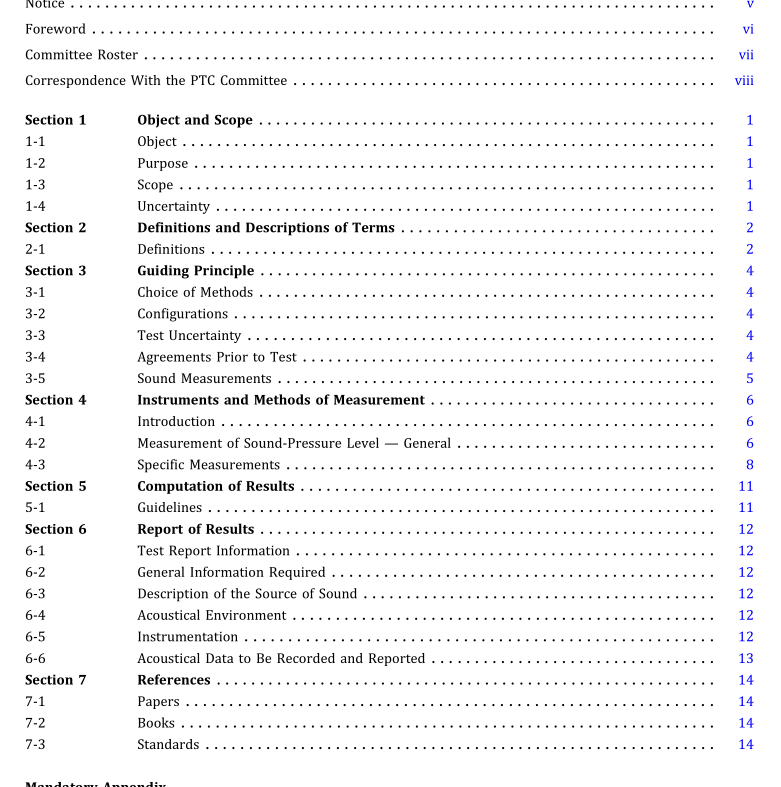ASME PTC 36:2018 pdf free download Measurement of Industrial Noise Performance Test Codes
3-1 CHOICE OF METHODS
Procedures described in ANSI/ASA S1.13 and ANSI/ASA S12.18 shall be used to measure airborne sound-pressurelevels in a near field or far field under any conditions.ANSI/ASA S1.13 is primarily for indoor sound measurements,although it can be used outdoors,and ANSI/ASAS12.18 applies only to outdoor environments.Ifthe sound-power levelofoutdoor sources must be characterized, the methods of other recognized standards may be used.
3-2 CONFIGURATIONS
(a) Components to Be Tested. Equipment beingtested consist of a single component or an entire set of components thatinclude all or part of an industrial facility. The equipment may be located indoors or outdoors and may include theenclosure building(s) as a source of noise.This Code utilizes, by reference, existing standards and provides additionalinformational guidance in the application of those methodologies (see Nonmandatory Appendix B).
(b) Equipment Configuration.A wide range of potential equipment configurations are allowed for indoor and outdoornoise sources. For those situations in which the receiver sound levels of indoor equipment is the objective, correctionsshall be made for the reverberation effects of building surfaces (wall, floor, or ceiling).
3-3 TEST UNCERTAINTY
Tables3-3-1and3-3-2 provide approximate limits for test data correction and the estimated amount of correspondinguncertainty for various grades of measurement accuracy.Table3-3-1 defines thegrade ofaccuracy available to the user ofASME PTC36 based on the magnitude of the corrections.For example, a test for which the background noise correctionexceeds 1.3 dB or the environmental correction exceeds 2 dB cannot be considered an engineering grade test. Therefore,the uncertainty of thetestdata degrades to survey grade(orspecial case), which results in a greater degree of uncertainty.Table 3-3-2 showsthe estimated uncertainty associated with engineering grade and survey grade test results, expressedas the 95% confidence intervalor 2 times the standard deviation.Both tables come from IS010494.Table 3-3-2is slightlymodified. If test result corrections exceed the allowable range for engineering grade or survey grade accuracy, theuncertainty will be greater than that shown in Table 3-3-2 and will require evaluation on a case-by-case basis.ln the absence of contractually negotiated test uncertainty,Table 3-3-2 can be used. If the test methodology has usedone of the referenced standards in this Code, the uncertainty given in the referenced standard, if any, shall be stated.Nonmandatory Appendix B may be appropriate if the user of this Code is in a situation where he/she is required to testunder conditions outside the allowable parameters in the referenced standards.
3-4 AGREEMENTS PRIOR TO TEST
The partiesto a test conducted underthisCode should reach agreement on the itemslisted in paras.3-4.1 through3-4.5prior to the test. In many cases, the parties may need to agree on only one of the referenced standards.
3-4.1 Test Objectives
The objective(s) of the test shall be defined as obtaining one or both of the following:
(a) near-field sound-pressure level
(b) far-field sound-pressure level
3-4.2 Sound Survey Report
The sound survey report shall be defined in terms of the following:
(a) acoustical instrumentation
(b) microphone locations and orientation
(c) data retrieval and archiving methods to be used, such as direct readout, data storage, and data recording
(d) data reduction required
(e) expected measurement uncertainty
(f) corrections
3-4.3 Acoustical Environment
Theacousticalenvironmentwheretheequipmentcomponentsaretobetestedshallbedefined.Thefollowingvariables
shall be considered:
(a) free field or reverberant field
(b) reflecting surfaces
(c) contribution of auxiliary noise sources
(d) background noise
(e) atmospheric conditions
3-4.4 Operating Conditions
Equipmentcomponents to be tested shall be operated atconditions as stipulated. Arecord ofthe operatingconditions
shall be maintained. The following additional parameters shall be considered:
(a) location and mounting of equipment
(b) starting time of each acoustical test
(c) duration and number of tests
(d) number of times a measurement is made
(e) duration of operation at test conditions before measurements are made
(f) criteria for determining when test conditions are attained
(g) responsibility for control of operating conditions during test
3-4.5 Equipment Characteristics
Equipment to be tested shall be classified in terms of the following:
(a) size (physical dimensions); a controlled drawing, to be included in the report, may suffice
(b) mode of operation
(c) installation and mobility
(d) acoustical characteristics
ASME PTC 36:2018 pdf free download
